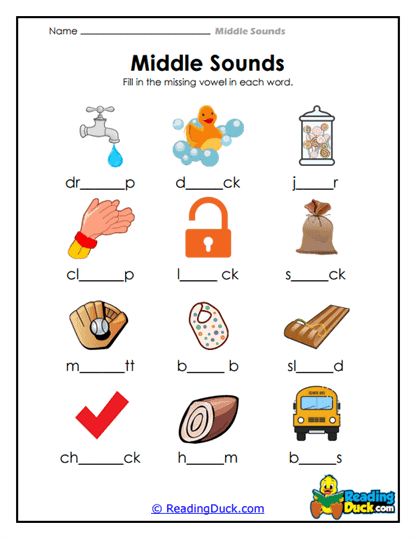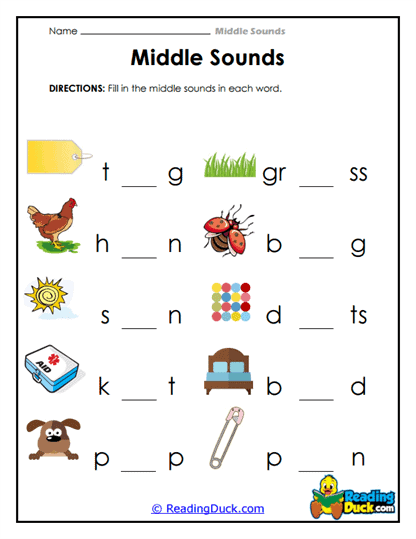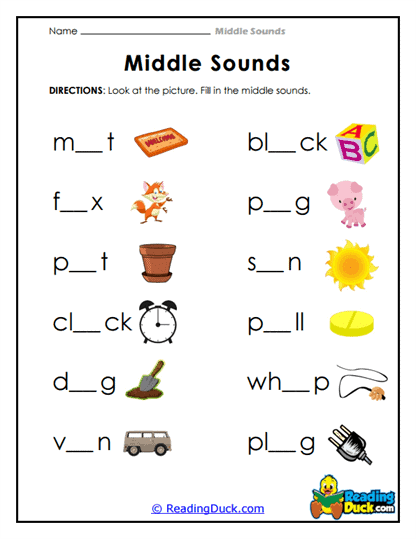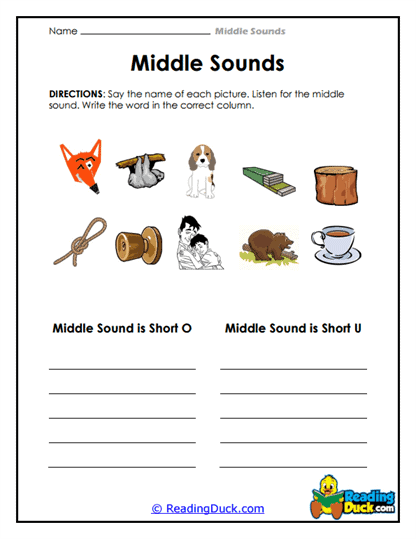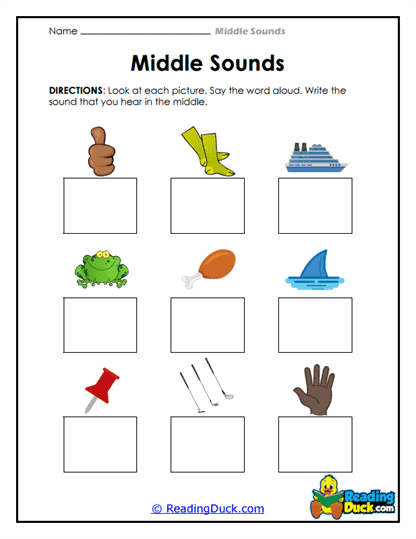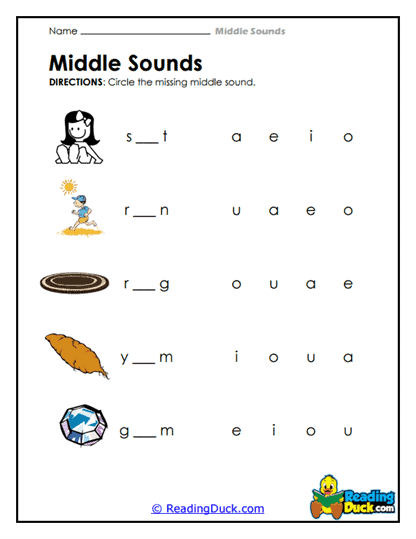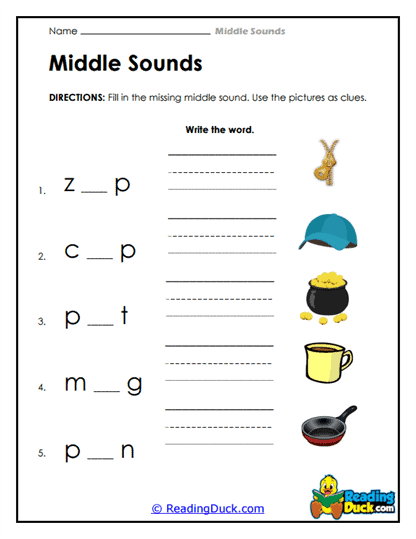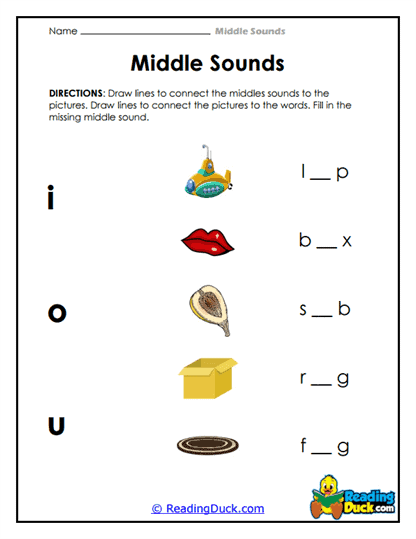Middle Sounds Worksheets
About Our Middle Sounds Worksheets
Our collection of Middle Sounds Worksheets is an invaluable resource for young learners who are in the early stages of developing their reading skills. These worksheets fall under the 'Phonics' category within the 'Pre-Reading' section, making them an essential part of any early literacy curriculum. Aimed primarily at students in Pre-K through 1st grade, these worksheets focus on helping children recognize and practice the sounds that occur in the middle of words, which is a crucial step in phonemic awareness and word recognition.
Each worksheet in this collection is available in PDF format, ensuring they are easy to view, download, and print. Additionally, every worksheet includes a downloadable answer key, enabling educators and parents to efficiently review and assess student progress. These worksheets are designed to provide systematic practice, reinforcing students’ understanding of middle sounds and contributing to their overall reading fluency and confidence.
Understanding Middle Sounds: A Fundamental Aspect of Early Reading Development
Middle sounds, also known as medial vowel sounds, refer to the vowel sounds found in the middle of words. These sounds are crucial in the development of phonemic awareness, as they play a key role in the process of decoding and spelling words. For example, in the word "cat," the middle sound is the short "a" vowel sound. Similarly, in the word "pig," the middle sound is the short "i" vowel sound.
Why Are Middle Sounds Important?
Mastering middle sounds is essential for several reasons:
- Phonemic Awareness: Recognizing middle sounds is a core component of phonemic awareness, which is the ability to hear, identify, and manipulate individual sounds (phonemes) in spoken words. This skill is a strong predictor of future reading success.
- Decoding Words: Being able to identify and articulate the middle sounds in words helps children decode unfamiliar words when reading. This is particularly important as children encounter more complex vocabulary.
- Spelling Skills: Understanding middle sounds also aids in spelling. Children who can accurately identify the middle sounds in words are better equipped to spell words correctly.
- Reading Fluency: As students become proficient in recognizing middle sounds, their reading fluency improves. They can read words more quickly and with greater confidence, which in turn enhances their overall comprehension.
Systematic Approach to Learning Middle Sounds
Teaching middle sounds involves a step-by-step approach that builds on students’ existing phonemic knowledge:
- Introduction to Vowel Sounds: Before focusing on middle sounds, students should be familiar with the basic vowel sounds (a, e, i, o, u). This foundational knowledge is essential for understanding how these sounds function in the middle of words.
- Sound Isolation: Once students are familiar with vowel sounds, the next step is to help them isolate the middle sound in simple CVC (consonant-vowel-consonant) words like "hat," "pen," and "dog."
- Blending and Segmenting: Teaching students to blend sounds together to form words and segment words into their individual sounds reinforces their understanding of middle sounds.
- Practice with Word Families: Grouping words with the same middle sounds into word families (e.g., "cat," "bat," "hat") helps students recognize patterns and reinforces the middle sound concept.
How These Worksheets Support the Recognition and Practice of Middle Sounds
Our Middle Sounds Worksheets are specifically designed to reinforce the recognition and practice of this vital phonemic skill. These worksheets provide a structured approach to learning, offering students various opportunities to engage with middle sounds in a meaningful way.
Reinforcement Through Repetition
The worksheets are designed to provide repeated exposure to middle sounds, helping students to internalize these sounds through consistent practice. Repetition is key in phonics instruction, as it solidifies the connection between the sound and the corresponding letter or letter combination.
Building Sound Discrimination Skills
One of the key goals of these worksheets is to help students distinguish between different vowel sounds that occur in the middle of words. By practicing with words that have similar beginning and ending sounds but different middle sounds (e.g., "cat" vs. "cot"), students learn to hear and identify the differences, which is crucial for both reading and spelling.
Progressive Learning
These worksheets are designed to progress in difficulty, allowing students to start with simpler tasks and gradually move on to more challenging ones as they build their confidence and skills. This gradual progression ensures that students do not become overwhelmed and can steadily improve their understanding of middle sounds.
Encouraging Independent Learning
As students become more comfortable with middle sounds, these worksheets can be used for independent practice. This fosters a sense of independence and confidence, as students can work through the activities on their own, reinforcing what they’ve learned in a supportive, self-paced environment.
Best Practices for Educators in Teaching Middle Sounds
Introducing Middle Sounds Through Familiar Words
When introducing middle sounds, it’s effective to start with words that are familiar to students. By using common CVC words that children already know, educators can help students focus on identifying the middle sound without being distracted by unfamiliar vocabulary.
Utilizing Multi-Sensory Approaches
A multi-sensory approach can be particularly effective in teaching middle sounds. For example, educators can combine auditory, visual, and kinesthetic activities by having students say the word aloud, look at the letters, and trace or write the word. This approach engages multiple senses, helping to reinforce the concept.
Incorporating Phonemic Awareness Activities
In addition to the worksheets, educators can use phonemic awareness activities to reinforce middle sounds. These might include sound matching games, where students identify the middle sound in a series of words, or sound sorting activities, where students categorize words based on their middle vowel sound.
Creating a Print-Rich Environment
Surrounding students with a print-rich environment can also support the learning of middle sounds. Word walls, posters, and labeled objects around the classroom can provide constant reinforcement of vowel sounds and help students make connections between the sounds they hear and the letters they see.
Regular Assessment and Feedback
Assessing students’ understanding of middle sounds through both formal and informal methods is crucial. Educators should provide immediate feedback to correct any misunderstandings and offer additional practice or support as needed. Regular check-ins help ensure that all students are progressing at an appropriate pace.
Practical Ideas for Using Worksheets to Enhance Literacy Skills
Incorporating Worksheets into Daily Routines
These worksheets can be easily integrated into daily classroom or homeschool routines. For example, educators might use a worksheet as part of a morning literacy warm-up, during small group instruction, or as an independent activity during center time. Regular use helps reinforce the skills being taught.
Pairing Worksheets with Interactive Activities
To make learning more dynamic, educators can pair worksheets with interactive activities. For instance, after completing a worksheet on middle sounds, students might participate in a matching game where they pair words with similar middle sounds or create a simple story using words from the worksheet.
Encouraging Parental Involvement
Parents can play a key role in reinforcing middle sounds at home. Educators can send worksheets home as part of a weekly homework packet, encouraging parents to review the material with their children. Simple activities like reading aloud together or playing vowel sound games can complement the worksheet practice.
Extending Learning Beyond the Worksheet
Worksheets can also serve as a springboard for more creative literacy activities. After completing a worksheet, students could be encouraged to come up with their own words that have the same middle sound or to create a drawing that represents a word they practiced. This extension activity helps solidify the concept in a fun and engaging way.
Adapting Worksheets for Differentiated Instruction
The worksheets can be adapted to meet the needs of diverse learners. For students who need extra support, educators might focus on simpler, more repetitive tasks, while advanced students could be challenged to find additional words with the same middle sounds or to write sentences using those words.
The Importance of Middle Sounds Worksheets in Building Reading Confidence
In conclusion, our Middle Sounds Worksheets are an essential tool for developing phonemic awareness and building a strong foundation in early reading skills. By focusing on the recognition and practice of middle sounds, these worksheets help students develop the ability to decode words, spell correctly, and read fluently.
The structured and progressive nature of these worksheets ensures that students can build their skills at a comfortable pace, gaining confidence in their abilities as they go. Whether used in a classroom or homeschool setting, these worksheets provide consistent, targeted practice that reinforces key phonics concepts and helps students achieve reading success.
Ultimately, mastery of middle sounds through these worksheets is a crucial step in a child’s literacy journey. By using these worksheets thoughtfully and creatively, educators and parents can significantly enhance a child’s early literacy skills, setting them on the path to becoming confident, proficient readers. This foundational skill will not only contribute to their academic success but also foster a lifelong love of reading and learning.
